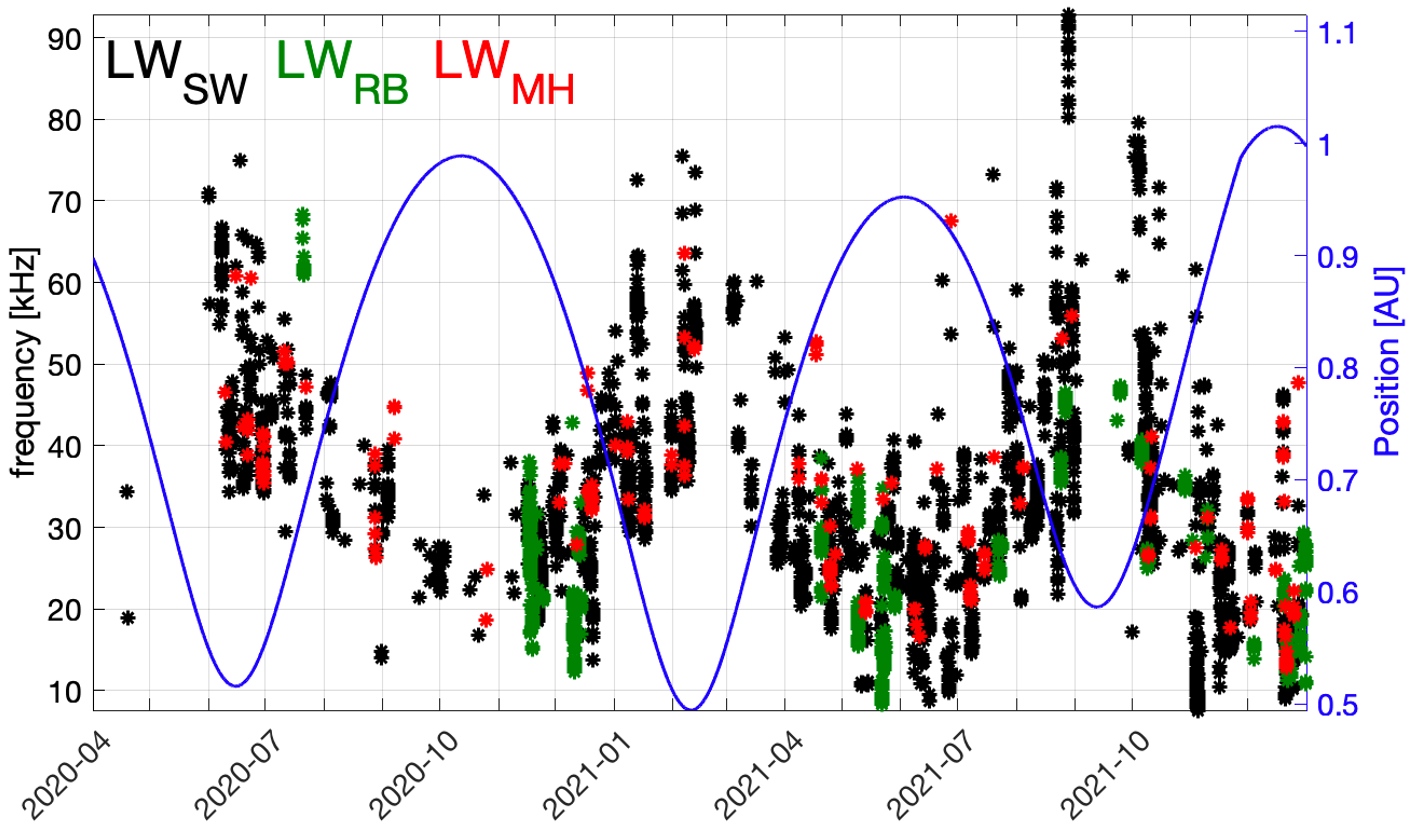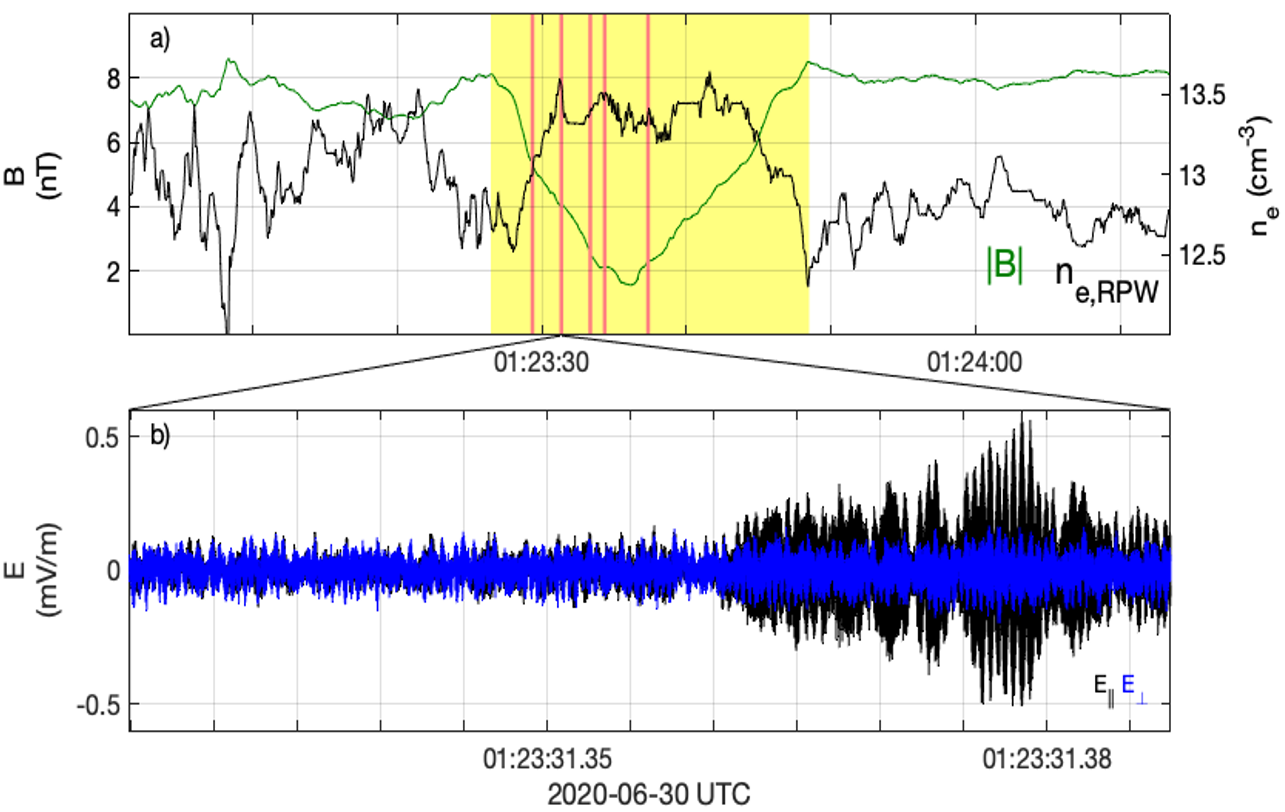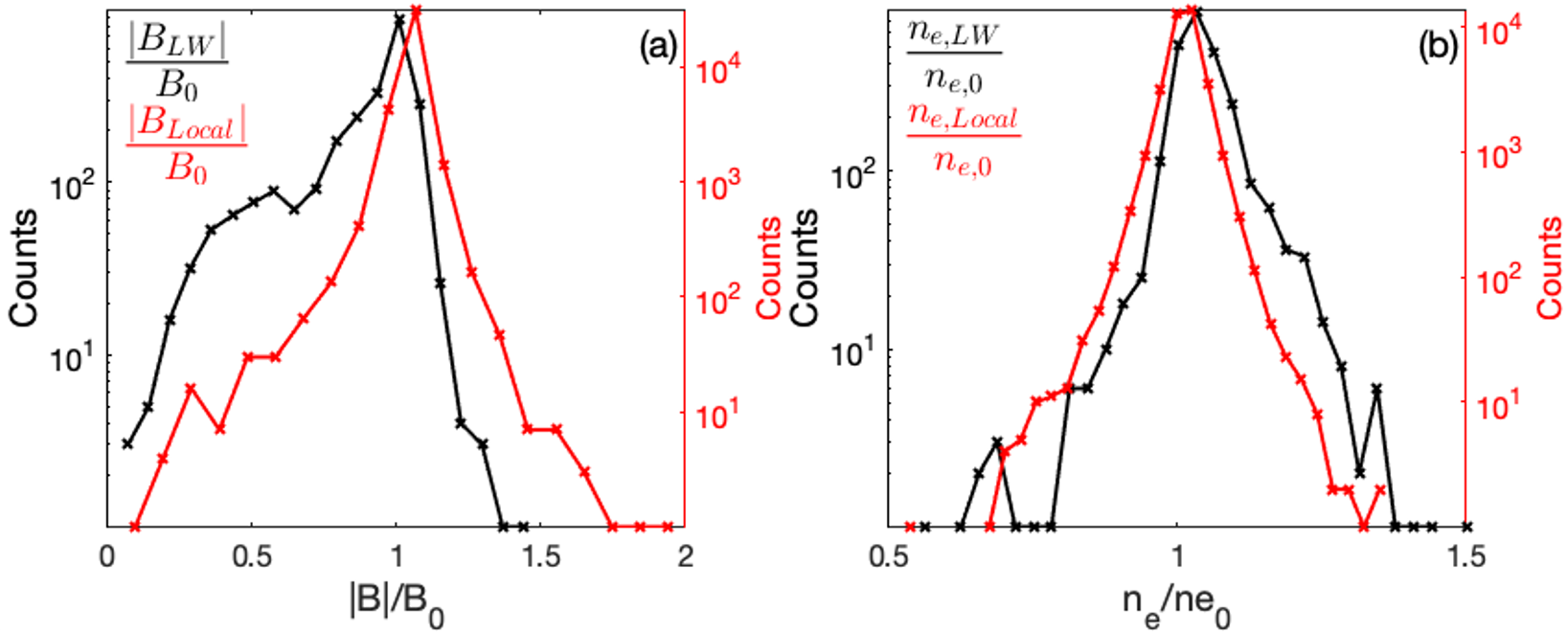Science nugget: Langmuir waves associated with magnetic holes in the solar wind - Solar Orbiter
Langmuir waves associated with magnetic holes in the solar wind
(Solar Orbiter nugget #3 by J.J. Boldú1,2, D. B. Graham1, M. Morooka1, M. André1 Yu. V. Khotyaintsev1, T. Karlsson3, J. Souček4, D. Píša4, and M. Maksimovic5)
Introduction
Langmuir waves are electrostatic waves near the electron plasma frequency, often observed in the solar wind. In a weakly collisional environment, such as the solar wind, wave-particle interactions play a fundamental role in the energy dissipation mechanisms. The study of Langmuir waves is of particular interest, as they could play an important role in solar wind electron thermodynamics. They also provide a reliable way to diagnose the electron density, and the knowledge of Langmuir wave properties can be used for calibration purposes of particle detectors.
Statistical characteristics of Langmuir waves
The largest amplitude Langmuir waves in the solar wind are typically associated with type II and type III radio bursts. However, Langmuir waves unrelated to radio bursts also occur in the solar wind, but their source is still not well understood. Langmuir waves have been previously observed inside magnetic field depressions at 1 au, specifically inside magnetic holes [1,2]. A magnetic hole is defined as a region with a magnetic field depression of 50% or more from the background magnetic field level [3]. Magnetic holes are commonly found in the solar wind. These structures have magnetic pressure, typically, balanced by the plasma pressure and their presence can affect the energy transport in the solar wind, having an impact on its large-scale structure [4].
Thanks to the Radio and Plasma Waves (RPW) instrument onboard the Solar Orbiter spacecraft, we have identified Langmuir waves at different heliocentric distances between 0.5 and 1 au [5]. Langmuir waves are detected in the form of high-resolution snapshots, and we have associated these waves with different source regions, such as radio bursts and magnetic holes. In Figure 1 we show the frequency of all Langmuir waves detected and at which distance from the sun they occurred. When looking at the RPW-triggered waveforms snapshots, we found that ~27% of the Langmuir waves are related to radio bursts (green).
Of the remaining Langmuir waves (black), 78% occurred in magnetic field depressions, which include the ones inside magnetic holes (red).

Fig. 1: Radial distribution of Langmuir waves throughout different heliocentric distances as seen by Solar Orbiter. Langmuir waves are related to different source regions: radio bursts (green), magnetic holes (red), and solar wind Langmuir waves not related to radio bursts or magnetic holes (black). The radial distance is plotted for reference (blue). The frequency of Langmuir waves is inversely proportional to the electron density.
An example of a magnetic hole containing several Langmuir waves seen by Solar Orbiter is shown in the interval highlighted in yellow in Fig. 2a. The magnetic hole is characterized by a localized decrease in the magnetic field magnitude and an increase in density. Each red vertical line indicates the time of a Langmuir wave. The snapshot in Fig. 1b shows the two components of the measured electric field. Here Eperp (blue) is perpendicular to the magnetic field and Epara (black) is the component aligned with the projection of the magnetic field in the Solar Orbiter’s antenna plane. For this snapshot, we find that Epara>>Eperp, which is expected for Langmuir waves.

Fig. 2: Example of a magnetic hole containing several Langmuir waves. (a) Magnetic field magnitude (green) and electron density (black). The yellow background indicates the interval considered as a magnetic hole. Five Langmuir waves were spotted inside this magnetic hole (red vertical lines). (b) Parallel (black) and perpendicular (blue) components of the electric field high-resolution snapshot of the second Langmuir wave observed in the presented magnetic hole.
Plasma conditions near solar wind Langmuir waves
With our data set of Langmuir waves, we analyzed the solar wind conditions in the regions of Langmuir wave activity. Then, we characterized the importance of magnetic field depressions as Langmuir waves source regions in the solar wind. We found that most of the Langmuir waves that are not related to radio bursts occurred in magnetic field depressions (Fig 3a).
We compared the local conditions of all the solar wind regions monitored by Solar Orbiter to rule out that Langmuir waves are more common in magnetic field depressions simply because magnetic field depressions occur more often in the solar wind than magnetic field enhancements. The red distribution in Fig. 3a shows that magnetic field depressions are equally as common as magnetic field enhancements in the solar wind. Nevertheless, we observe higher counts of Langmuir waves from the black distribution when the local magnetic field is below the magnetic field background level B0.

Fig. 3: Magnetic field and density solar wind conditions. (a) Local magnetic field conditions with respect to the background level at the time of the Langmuir waves (black) and in all the solar wind monitored by Solar Orbiter (red). (b) Local electron density conditions with respect to the background density at the time of the Langmuir waves (black) and in all the solar wind monitored by Solar Orbiter (red).
We also found that Langmuir waves tend to occur in density enhancements, as seen in Fig. 3b. The increase of Langmuir wave counts at density enhancements and magnetic field depressions suggest that these waves tend to form in pressured balance structures, such as magnetic holes.
Conclusion
We performed a statistical study of Langmuir waves at heliocentric distances between 0.5 and 1 AU using Solar Orbiter/RPW data. We found that solar wind Langmuir waves tend to occur in magnetic field depressions. Furthermore, 8% of these solar wind Langmuir waves were found inside the deepest magnetic field depressions, defined as magnetic holes.
1Swedish Institute of Space Physics (IRF), Uppsala 75121, Sweden.
2Department of Physics and Astronomy, Uppsala University, Uppsala, Sweden.
3Division of Space and Plasma Physics, School of Electrical Engineering and Computer Science, KTH Royal Institute of Technology, Stockholm 11428, Sweden.
4Institute of Atmospheric Physics of the Czech Academy of Sciences, Prague, Czechia.
5LESIA, Observatoire de Paris, Université PSL, CNRS, Sorbonne Université, Univ. Paris Diderot, Sorbonne Paris Cité, 5 place Jules Janssen, 92195 Meudon, France
References
[1] Lin, N., Kellogg, P. J., MacDowall, R. J., et al. 1995, Geophysical Research Letters, 22, 3417
[2] MacDowall, R. J., Lin, N., Kellogg, P. J., et al. 1996 (AIP Publishing), 301–304
[5] Boldú, J.J., Graham, D.B., Morooka, M., et al. 2023, A&A, 674, 220
- Removed a total of (2) style text-align:center;
- Removed a total of (46) style text-align:justify;
- Removed a total of (1) style margin:0;
Nuggets archive
2025
09/04/2025: Bursty acceleration and 3D trajectories of electrons in a solar flare
02/04/2025: Picoflare jets in the coronal holes and their link to the solar wind
19/03/2025: Radial dependence of solar energetic particle peak fluxes and fluences
12/03/2025: Analysis of solar eruptions deflecting in the low corona
05/03/2025: Propagation of particles inside a magnetic cloud: Solar Orbiter insights
19/02/2025: Rotation motions and signatures of the Alfvén waves in a fan-spine topology
12/02/2025: 'Sun'day everyday: 2 years of Solar Orbiter science nuggets that shed light on some of our star's mysteries
22/01/2025: Velocity field in the solar granulation from two-vantage points
15/01/2025: First joint X-ray solar microflare observations with NuSTAR and Solar Orbiter/STIX
2024
18/12/2024: Shocks in tandem : Solar Orbiter observes a fully formed forward-reverse shock pair in the inner heliosphere
11/12/2024: High-energy insights from an escaping coronal mass ejection
04/12/2024: Investigation of Venus plasma tail using the Solar Orbiter, Parker Solar Probe and Bepi Colombo flybys
27/11/2024: Testing the Flux Expansion Factor – Solar Wind Speed Relation with Solar Orbiter data
20/11/2024:The role of small scale EUV brightenings in the quiet Sun coronal heating
13/11/2024: Improved Insights from the Suprathermal Ion Spectrograph on Solar Orbiter
30/10/2024: Temporally resolved Type III solar radio bursts in the frequency range 3-13 MHz
23/10/2024: Resolving proton and alpha beams for improved understanding of plasma kinetics: SWA-PAS observations
25/09/2024: All microflares that accelerate electrons to high-energies are rooted in sunspots
25/09/2024: Connecting Solar Orbiter and L1 measurements of mesoscale solar wind structures to their coronal source using the Adapt-WSA model
18/09/2024: Modelling the global structure of a coronal mass ejection observed by Solar Orbiter and Parker Solar Probe
28/08/2024: Coordinated observations with the Swedish 1m Solar Telescope and Solar Orbiter
21/08/2024: Multi-source connectivity drives heliospheric solar wind variability
14/08/2024: Composition Mosaics from March 2022
19/06/2024: Coordinated Coronal and Heliospheric Observations During the 2024 Total Solar Eclipse
22/05/2024: Real time space weather prediction with Solar Orbiter
15/05/2024: Hard X ray and microwave pulsations: a signature of the flare energy release process
01/02/2024: Relativistic electrons accelerated by an interplanetary shock wave
11/01/2024: Modelling Two Consecutive Energetic Storm Particle Events observed by Solar Orbiter
2023
14/12/2023: Understanding STIX hard X-ray source motions using field extrapolations
16/11/2023: EUI data reveal a "steady" mode of coronal heating
09/11/2023: A new solution to the ambiguity problem
02/11/2023: Solar Orbiter and Parker Solar Probe jointly take a step forward in understanding coronal heating
25/10/2023: Observations of mini coronal dimmings caused by small-scale eruptions in the quiet Sun
18/10/2023: Fleeting small-scale surface magnetic fields build the quiet-Sun corona
27/09/2023: Solar Orbiter reveals non-field-aligned solar wind proton beams and its role in wave growth activities
20/09/2023: Polarisation of decayless kink oscillations of solar coronal loops
23/08/2023: A sharp EUI and SPICE look into the EUV variability and fine-scale structure associated with coronal rain
02/08/2023: Solar Flare Hard Xrays from the anchor points of an eruptive filament
28/06/2023: 3He-rich solar energetic particle events observed close to the Sun on Solar Orbiter
14/06/2023: Observational Evidence of S-web Source of Slow Solar Wind
31/05/2023: An interesting interplanetary shock
24/05/2023: High-resolution imaging of coronal mass ejections from SoloHI
17/05/2023: Direct assessment of far-side helioseismology using SO/PHI magnetograms
10/05/2023: Measuring the nascent solar wind outflow velocities via the doppler dimming technique
26/04/2023: Imaging and spectroscopic observations of EUV brightenings using SPICE and EUI on board Solar Orbiter
19/04/2023: Hot X-ray onset observations in solar flares with Solar Orbiter/STIX
12/04/2023: Multi-scale structure and composition of ICME prominence material from the Solar Wind Analyser suite
22/03/2023: Langmuir waves associated with magnetic holes in the solar wind
15/03/2023: Radial dependence of the peak intensity of solar energetic electron events in the inner heliosphere
08/03/2023: New insights about EUV brightenings in the quiet sun corona from the Extreme Ultraviolet Imager








































 Sign in
Sign in
 Science & Technology
Science & Technology